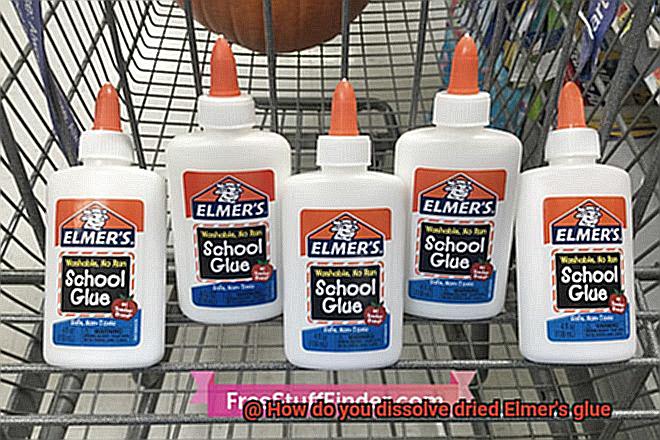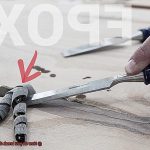Ever stumbled upon a forgotten art project or craft only to find that the glue has dried up and turned into a rock-solid mess? Or accidentally spilled Elmer’s glue on a surface, watched it dry, and now you’re stuck with an unsightly stain? Fear not. We’ve got you covered.
In this article, we’re going to answer the age-old question: how do you dissolve dried Elmer’s glue? You’ll be pleasantly surprised to know that the solution is right in your kitchen pantry or medicine cabinet.
From vinegar to rubbing alcohol, we’ll provide you with several solutions that you can try at home using common household items. No more throwing out projects or living with dried-up glue stains.
But wait, there’s more. We’ll also share tips on how to remove dried glue from different surfaces such as clothes, carpet, and even wood without causing damage.
So grab a cup of coffee, sit down, and get ready to learn how to dissolve dried Elmer’s glue once and for all. Say goodbye to those pesky stains and hello to a world of creative possibilities.
What is Elmer’s Glue?
Contents
- 1 What is Elmer’s Glue?
- 2 Why Does Elmer’s Glue Dry Out?
- 3 How to Dissolve Dried Elmer’s Glue with Warm Water
- 4 How to Dissolve Dried Elmer’s Glue with Dish Soap or Vinegar
- 5 How to Dissolve Dried Elmer’s Glue with Rubbing Alcohol or Acetone
- 6 Specialized Glue Remover Products
- 7 Tips for Successfully Removing Dried Elmer’s Glue
- 8 Conclusion
For decades, Elmer’s Glue has been the go-to adhesive for a multitude of applications. From school projects to woodworking, this versatile adhesive has stood the test of time. But what exactly is Elmer’s Glue and why is it so popular?
Elmer’s Glue is a white, water-based adhesive that dries clear and can be easily cleaned up with water while still wet. It is made from a combination of polyvinyl acetate (PVA) and other additives that give it its unique properties. PVA is a synthetic polymer that is commonly used as a binder in various applications, including adhesives. It is known for its excellent adhesive properties, strength, flexibility, and resistance to water and chemicals. PVA is also non-toxic, making it safe for use in schools and homes.
Elmer’s Glue comes in different varieties to cater to specific needs. School glue is designed to bond paper and cardboard, while wood glue is formulated to bond wood and other porous materials. Multipurpose glue can be used on a variety of surfaces, while clear glue dries transparently for an invisible bond.

But what if you accidentally spill Elmer’s Glue on a surface and it dries? Don’t worry, there are ways to remove it. Warm water is the most common solvent used to dissolve dried Elmer’s Glue. If that doesn’t work, adding dish soap or vinegar to the water can create a stronger solution. Rubbing alcohol or acetone can also be used but should be tested on a small area first.
In addition to its versatility and ease of use, Elmer’s Glue also has another advantage – it fosters creativity. The brand has even launched various campaigns to encourage people to embrace their artistic side by using their products in unique ways.
Why Does Elmer’s Glue Dry Out?
Elmer’s glue is a beloved adhesive used by many people, particularly children who rely on it for their school projects. However, one of the prevalent issues with this popular glue is that it can dry out over time, making it challenging to use. So, why does Elmer’s glue dry out? Let’s explore this phenomenon in detail.
The primary reason behind the drying out of Elmer’s glue is the evaporation of water. This adhesive consists of polyvinyl acetate (PVA) and water. PVA is a type of polymer that forms a robust bond when it dries. However, any loss of moisture can cause the glue to dry out as water is a crucial component in this process.
Apart from water loss, exposure to air and heat can also contribute to the drying out of Elmer’s glue. When you open the bottle, air enters and reacts with the PVA and water mixture, causing it to thicken and eventually dry out. Similarly, storing the bottle in a warm or dry place leads to quick evaporation of moisture content in the glue, resulting in its drying out.
But don’t fret. Even if your Elmer’s glue has dried out, it’s not necessarily useless. There are several ways to revive dried-out Elmer’s glue, such as adding a few drops of water or heating it up slightly. These techniques will be discussed in further detail in my upcoming blog post.
How to Dissolve Dried Elmer’s Glue with Warm Water
Dissolving dried Elmer’s glue can be a real headache, especially when it’s stuck on delicate surfaces like paper or fabric. Luckily, warm water is one of the best and safest methods to get rid of dried glue stains. Here are six simple steps to dissolve dried Elmer’s glue using warm water:
Fill a container with warm water
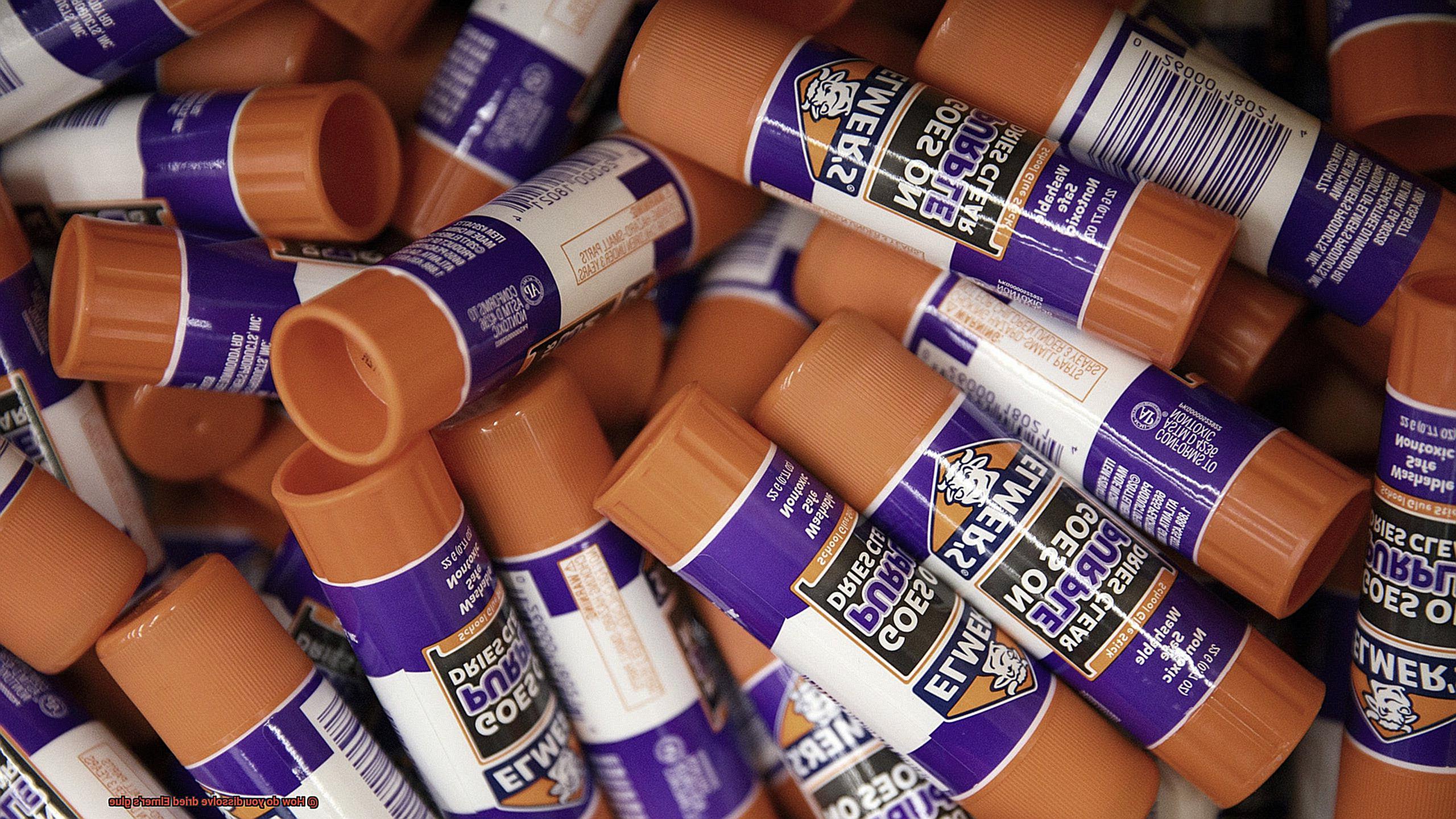
Begin by filling a bowl or container with warm water. The water should be warm enough to be comfortable to the touch but not too hot.
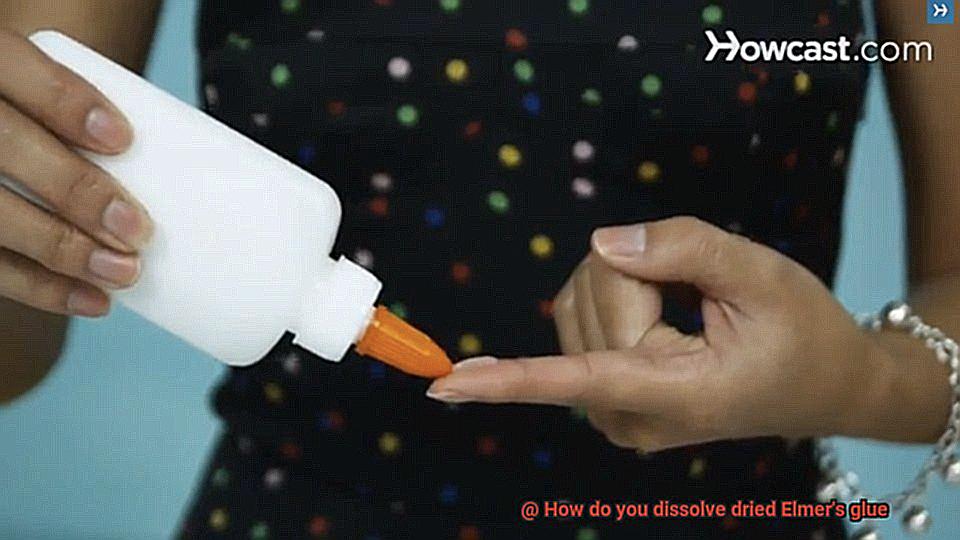
Soak the affected area
Place the item with the dried Elmer’s glue in the bowl of warm water and let it soak for several minutes. The warm water will penetrate the glue and start to dissolve it.
Gently scrub the area
After soaking, use a soft-bristled brush or sponge to gently rub or scrub the affected area. This will help speed up the process and remove any remaining glue residue. But be cautious not to damage delicate surfaces.
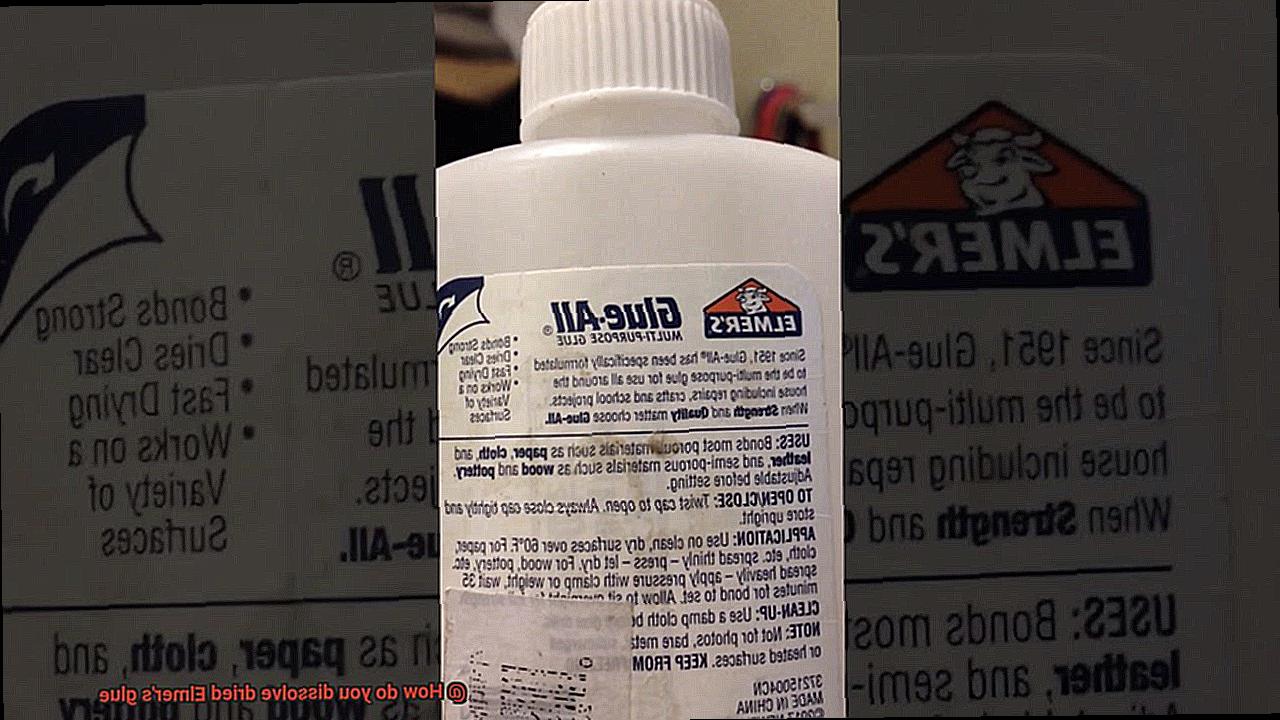
Rinse and dry the item
Once the glue has dissolved, rinse the item thoroughly with clean water and allow it to dry completely before using it again.
Use vinegar or dish soap
If there are any stubborn spots of dried glue that do not dissolve with warm water alone, you can try using a mixture of warm water and white vinegar or dish soap to help break down the glue further. Mix a few drops of dish soap with warm water and apply it to the affected area, then let it sit for several minutes before scrubbing it gently.
Teach responsible clean-up habits
Using warm water to dissolve dried Elmer’s glue is also an excellent way to teach children about responsible clean-up habits after art projects and activities.

How to Dissolve Dried Elmer’s Glue with Dish Soap or Vinegar
Do you have pesky, dried Elmer’s glue stains on your surfaces or fabrics that seem impossible to remove? Don’t fret, as there is a solution. You can remove them easily with two common household items: dish soap and vinegar. Here’s how you can use these two ingredients to say goodbye to those stubborn dried glue stains.
The Science Behind Dish Soap and Vinegar
Dish soap and vinegar are both effective in dissolving dried Elmer’s glue because of their unique properties. Dish soap contains enzymes that break down the proteins in glue, while vinegar is an acid that can dissolve the adhesive bonds. When used correctly, these ingredients can help you easily remove dried glue stains.
How to Use Dish Soap
To dissolve dried Elmer’s glue with dish soap, start by wetting the area with warm water. Then, apply a small amount of dish soap directly onto the dried glue and let it sit for a few minutes. After the dish soap has had some time to work its magic, use a damp cloth or sponge to gently scrub away the glue. If the glue is particularly stubborn, you may need to repeat this process a few times until it is completely dissolved.
How to Use Vinegar
To dissolve dried Elmer’s glue with vinegar, start by warming it up in a pot on the stove or in the microwave. Once it is warm (but not boiling), pour it onto the dried glue and let it sit for 10-15 minutes. After the vinegar has had some time to work its magic, use a damp cloth or sponge to gently scrub away the glue. Like with dish soap, you may need to repeat this process a few times until all of the glue is dissolved.
Precautions
It’s important to note that both dish soap and vinegar can be harsh on certain surfaces, so be sure to test them on a small, inconspicuous area first before using them on a larger scale. Additionally, be sure to wear gloves and work in a well-ventilated area when using these solutions.
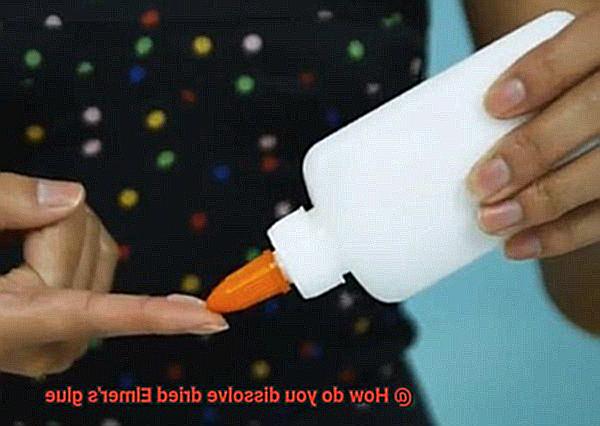
Alternative Solution
If you’re trying to remove dried Elmer’s glue from fabric or clothing, you may want to try using rubbing alcohol instead of dish soap or vinegar. Rubbing alcohol is a gentler option that can dissolve the glue without damaging the fabric.
How to Dissolve Dried Elmer’s Glue with Rubbing Alcohol or Acetone
Removing dried Elmer’s glue can be a challenging task, but fear not. There are effective solutions available to dissolve the glue and make it easier to clean up. Two of the most widely used methods for dissolving dried Elmer’s glue are rubbing alcohol and acetone. In this article, we will delve into the details of how these solvents can be used to remove dried Elmer’s glue effectively.
Rubbing alcohol, also known as isopropyl alcohol, is a common household item that can be found in most medicine cabinets. It is a great solvent for removing dried Elmer’s glue because it breaks down the molecular structure of the glue. To use rubbing alcohol to dissolve dried glue, simply apply a small amount of the alcohol onto the affected area and let it sit for a few minutes. Then, gently scrub the area with a soft-bristled brush or cloth until the glue starts to dissolve. Repeat this process until all of the glue has been removed.
Acetone is another useful solvent for dissolving dried Elmer’s glue. It is commonly found in nail polish remover and paint thinner. Like rubbing alcohol, it breaks down the molecular structure of the glue, making it easier to remove. To use acetone to dissolve dried glue, apply a small amount onto the affected area and let it sit for a few minutes. Then, gently scrub the area with a soft-bristled brush or cloth until the glue starts to dissolve. Repeat as necessary until all of the glue has been removed.
However, it’s important to note that both rubbing alcohol and acetone can be harsh on certain materials such as plastic or painted surfaces. It is always best to test a small, inconspicuous area before applying either solvent to a larger area. This way, you can ensure that there will be no damage to your surface.
In addition, when using either solvent, it is important to work in a well-ventilated area and wear gloves to protect your skin. Always read and follow the instructions on the label of any product you use. This will ensure that you are using the product safely and effectively.
Specialized Glue Remover Products
Fear not, as specialized glue remover products are here to save the day. These products are specifically designed to break down the chemical bonds of the glue, making it easier to remove from surfaces.
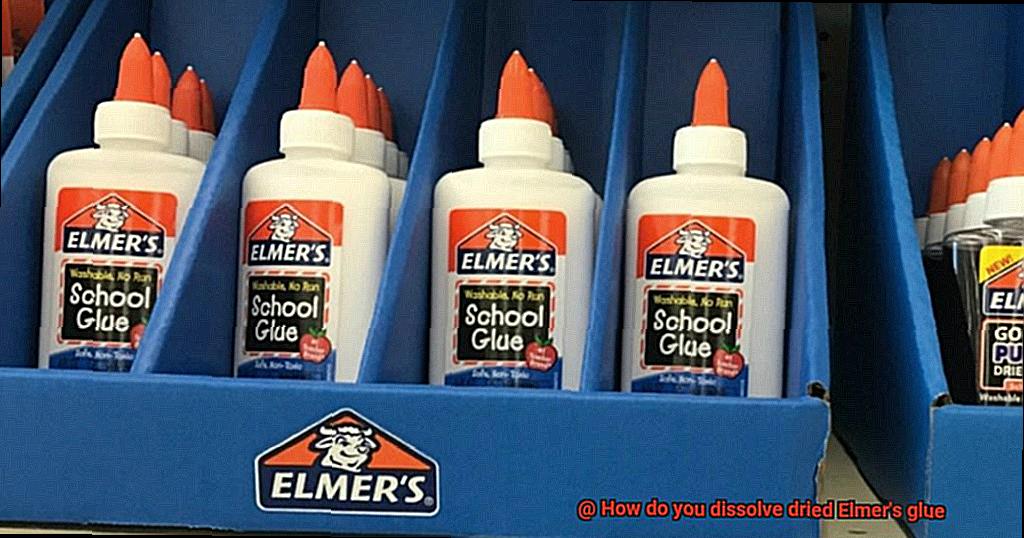
There are several types of specialized glue remover products available in the market, each with its own unique formulation and application method. One such type is solvent-based glue removers, which contain chemicals like acetone, toluene, or ethyl acetate to dissolve the glue. These products are ideal for tough surfaces like wood, metal, and plastic, but caution must be exercised when using them on delicate materials.
If you’re looking for a safer option for delicate surfaces like fabrics or paper, water-based glue removers are the way to go. These products use a combination of water and surfactants to break down the glue without causing any damage to the surface. However, they may not be as effective as solvent-based removers on tougher surfaces.
For a more precise application method, gel-based glue removers are an excellent choice. The thicker consistency allows for direct application onto the dried glue without the risk of spills or drips. However, gel-based removers may require additional time to dissolve the glue fully.
When using specialized glue remover products, it’s essential to follow the manufacturer’s instructions carefully. Some products require a specific amount of time to dwell on the surface before wiping away, while others may require multiple applications for stubborn or thick layers of glue. It’s also important to wear gloves and work in a well-ventilated area when using solvent-based products.
Tips for Successfully Removing Dried Elmer’s Glue
Removing dried Elmer’s glue can be a daunting task, but don’t worry. With a little bit of patience and the right tools, you can get the job done. Here are five effective methods for successfully removing dried Elmer’s glue.
Hot Water
Soak the affected area in hot water for a few minutes. This will soften the glue and make it easier to remove. You can also use a cloth or sponge soaked in hot water to apply to the glue. If the glue is particularly stubborn, add a small amount of dish soap to the water to help break down the glue.
Vinegar
Vinegar is an excellent solvent that can help dissolve dried Elmer’s glue. Simply apply some vinegar to the affected area and let it sit for a few minutes. Then, use a scraper or a cloth to remove the glue. If you’re working with delicate surfaces like fabrics or wallpapers, dilute the vinegar with water before application.
Rubbing Alcohol
Rubbing alcohol is another great solvent that can help dissolve dried Elmer’s glue. Apply some rubbing alcohol to a cloth and rub the area with the dried glue. This should soften the glue and make it easier to remove.
Oil
Oil can also be used to remove dried Elmer’s glue. Apply some oil such as vegetable oil, coconut oil or baby oil to the affected area and let it sit for a few minutes. Then, use a scraper or a cloth to remove the glue. The oil helps to break down the adhesive properties of the glue, making it easier to remove.
Scraper
A scraper can be an effective tool for removing dried Elmer’s glue, especially from hard surfaces like countertops or tables. Gently scrape away at the glue until it comes off of the surface. Be careful not to scratch or damage the surface while doing so.
Also Read: Will Elmer’s glue dissolve in water?
Conclusion
In conclusion, removing dried Elmer’s glue stains is no easy feat, but fear not. With the right tools and techniques, you can easily dissolve those pesky marks. Warm water is a safe and effective method to remove dried glue stains, while vinegar and dish soap are equally great alternatives that work wonders.
For tougher adhesive bonds, specialized glue remover products are available in the market. However, caution should be exercised when using these products on delicate surfaces. Rubbing alcohol and acetone are powerful solvents that can break down the molecular structure of the glue, making it easier to remove.
Patience is key when dealing with dried Elmer’s glue stains as some methods may require multiple applications or time to dwell on the surface before wiping away. It’s essential to follow manufacturer instructions carefully when using specialized glue remover products and wear gloves while working in a well-ventilated area when using solvent-based products.
By following these tips and techniques, you can successfully remove dried Elmer’s glue from various surfaces without causing damage.

